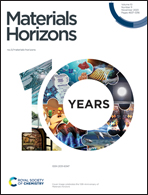Establishing a unified paradigm of microwave absorption inspired by the merging of traditional microwave absorbing materials and metamaterials†
Abstract
The merging of traditional microwave absorbing materials with metamaterials holds significant potential for enhancing microwave absorber performance. To unlock this potential, a unified paradigm is urgently required. We have successfully established such a paradigm, focusing on regulating effective electromagnetic parameters and interfacial forms across microscopic, mesoscopic, and macroscopic scales. Building upon this foundation, we introduce an active co-design methodology for jointly optimizing full-scale structures and the concept of “full-scale microwave absorbers” (FSMAs). Under this guidance, performance improvements can be achieved efficiently, leading to crucial breakthroughs. For demonstration, we present a case study designing ultra-thin miniaturized FSMAs capable of ultra-broadband and low-frequency absorption. Simulation results show absorptivity exceeding 90% in the 2–28 GHz range, with absorptivity surpassing 85% and 74% in the 1.5–2 GHz and 1–1.5 GHz ranges, respectively. Additionally, the total thickness and macro period are only 5 mm, roughly equivalent to 0.033 wavelengths of the lowest operating frequency. Most importantly, we have broken the Rozanov limit, with experimental results further validating this design. This work significantly enhances our understanding of microwave absorption and offers a shortcut for pursuing improved performances and breakthroughs.



 Please wait while we load your content...
Please wait while we load your content...